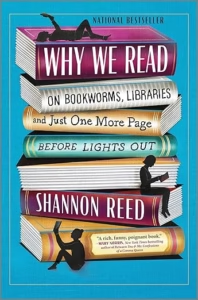Why We Read: On Bookworms, Libraries, and Just One More Page Before Lights Out
Shannon Reed
Hanover Square Press
Published February 6, 2024
Amazon | Bookshop | Goodreads
About Why We Read
A hilarious and incisive exploration of the joys of reading from a teacher, bibliophile and Thurber Prize finalist.
We read to escape, to learn, to find love, to feel seen. We read to encounter new worlds, to discover new recipes, to find connection across difference, or simply to pass a rainy afternoon. No matter the reason, books have the power to keep us safe, to challenge us, and perhaps most importantly, to make us more fully human.
Shannon Reed, a longtime teacher, lifelong reader, and New Yorker contributor, gets it. With one simple goal in mind, she makes the case that we should read for pleasure above all else. In this whip-smart, laugh-out-loud-funny collection, Reed shares surprising stories from her life as a reader and the poignant ways in which books have impacted her students. From the varied novels she cherishes ( Gone Girl , Their Eyes Were Watching God ) to the ones she didn’t ( Tess of the d’Urbervilles ), Reed takes us on a rollicking tour through the comforting world of literature, celebrating the books we love, the readers who love them, and the surprising ways in which literature can transform us for the better.
My Review
I finally read this book! I borrowed the ebook version from my library several times and couldn’t finish it within the loan time, so I ended up buying the audiobook version, and that was definitely the way to go for me.
The book’s description calls it “hilarious,” and, while there were some moments that made me laugh, I don’t know if I would call it hilarious. Like, it’s got great humor, but I feel like the author’s goal might be more in the realm of poignance than hilarity, and I think she succeeds at that. She shares experiences she has had as a reader that will be familiar to many bookish people:
- Weeping over a sad book.
- The discovery of a favorite author.
- The sometimes pretentious way that people can be about certain kinds of literature. *cough* Classics. *cough*
- Trying to navigate one’s personal triggers in literature, especially in what’s assigned in school/college.
- The impact of grief on the experience of reading or rereading a beloved book.
It was really fun reading a book that so thoroughly examines our draw toward stories and our sometimes complicated relationship with literature and books. I enjoyed the anecdotes from the author’s experience as a literature professor and her memories of her childhood as a reader.
In one chapter, she talks about her grief over the loss of her dad and how that impacted her reading. Wow. That one hit me hard. Her experience really resonated with me in terms of how grief makes it hard to engage with stories sometimes. I remember really struggling after a pregnancy loss because it seemed like every book my daughter wanted to read included a pregnant character or reference to one.
If reading or books have been an important part of your life, I think you’ll enjoy this one. The chapters each focus on a different reason for reading. Some will resonate more with academic readers, but others will resonate perfectly with casual readers or people recognized by their local librarians.
Content Notes
Recommended for Ages 12 up.
Representation
The author is a white woman who was born with hearing loss.
Profanity/Crude Language Content
Mild profanity used very infrequently.
Romance/Sexual Content
Vague references to romantic plot elements from books here or there.
Spiritual Content
Reed writes about her experience growing up as the daughter of a pastor, and her grief over the loss of her father.
Violent Content
Occasional vague references to violent plot elements (such as murder) from books.
Drug Content
None.
Note: This post contains affiliate links, which do not cost you anything to use but help support this blog. All opinions are my own.
